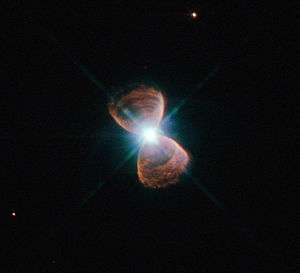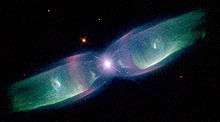Bipolar nebula

Bipolar planetary nebula PN Hb 12.[1]
A bipolar nebula is a distinctive nebular formation characterized by an axially symmetric bi-lobed appearance.
Many, but not all, planetary nebulae exhibit an observed bipolar structure. It may be that the two types of nebulae are directly related, one preceding or superseding the other in the evolution of the nebula.
Formation
Though the exact causes of this nebular structure are not known, it may be related to the physical process known as bipolar outflow in which a star ejects highly energetic streams of outflow along both poles. One theory states that these outflows collide with material surrounding the star (either stellar dust, or shells of matter sloughed off in a prior Supernova event).
Examples

Planetary Nebula M2-9, otherwise known as the Twin Jet Nebula or the Wings of a Butterfly Nebula, is a good example of a bipolar or two-lobed nebula.
- Homunculus Nebula around Eta Carinae [2][3][4][5]
- Hubble 5 [6]
- M2-9 – The Wings of a Butterfly Nebula [7][8][9]
- OH231.8+4.2 – The Calabash Nebula or Rotten Egg Nebula [10][11][11][12][13]
- Mz3 (or Menzel 3) – The Ant Nebula [14][15][16]
- CRL 2688 – The Egg Nebula [17][18][19][20]
- HD 44179 – The Red Rectangle Nebula [21][22][23]
- MyCn18 – The Hourglass Nebula [24][25][26][27][28]
- He2-104 – The Southern Crab Nebula [29][30][31]
- The Boomerang Nebula [32][33][34][35][36]
- NGC 2346 – Also known as Butterfly NGC 2346 [37]
References
- ↑ "Bizarre alignment of planetary nebulae". ESA/Hubble Press Release. Retrieved 6 September 2013.
- ↑ NewsCenter - Doomed Star Eta Carinae (06/10/1996) - Release Images. HubbleSite (10 June 1996). Retrieved on 2010-11-26.
- ↑ Nemiroff, R.; Bonnell, J., eds. (12 July 1995). "Eta Carinae Before Explosion". Astronomy Picture of the Day. NASA. Retrieved 2010-11-26.
- ↑ Nemiroff, R.; Bonnell, J., eds. (26 March 2006). "Doomed Star Eta Carinae". Astronomy Picture of the Day. NASA. Retrieved 2010-11-26.
- ↑ Eta Carinae Nebula (NGC 3372). Daviddarling.info (1 February 2007). Retrieved on 2010-11-26.
- ↑ HubbleSite – NewsCenter – Hubble Witnesses the Final Blaze of Glory of Sun-Like Stars (12/17/1997) – Release Images
- ↑ Nemiroff, R.; Bonnell, J., eds. (12 June 2005). "M2 9: Wings of a Butterfly Nebula". Astronomy Picture of the Day. NASA. Retrieved 2010-11-26.
- ↑ Nemiroff, R.; Bonnell, J., eds. (21 October 1997). "The Butterfly Planetary Nebula". Astronomy Picture of the Day. NASA. Retrieved 2010-11-26.
- ↑ Butterfly Nebula (M 2-9). Daviddarling.info (1 February 2007). Retrieved on 2010-11-26.
- ↑ NewsCenter - The "Rotten Egg" Nebula: A Planetary Nebula in the Making (10/19/1999) - Introduction. HubbleSite (19 October 1999). Retrieved on 2010-11-26.
- 1 2 APOD: 1 November 1999 - The Rotten Egg Planetary Nebula. Antwrp.gsfc.nasa.gov (1 November 1999). Retrieved on 2010-11-26.
- ↑ Nemiroff, R.; Bonnell, J., eds. (3 September 2001). "The Making of the Rotten Egg Nebula". Astronomy Picture of the Day. NASA. Retrieved 2010-11-26.
- ↑ Calabash Nebula (OH231.8+4.2). Daviddarling.info (1 February 2007). Retrieved on 2010-11-26.
- ↑ NewsCenter - Astro-Entomology? Ant-like Space Structure Previews Death of Our Sun (02/01/2001) - Introduction. HubbleSite (1 February 2001). Retrieved on 2010-11-26.
- ↑ Nemiroff, R.; Bonnell, J., eds. (1 May 2005). "Planetary Nebula Mz3: The Ant Nebula". Astronomy Picture of the Day. NASA. Retrieved 2010-11-26.
- ↑ Ant Nebula (Menzel 3). Daviddarling.info (1 February 2007). Retrieved on 2010-11-26.
- ↑ NewsCenter - Hubble Finds Searchlight Beams and Multiple Arcs around a Dying Star (01/16/1996) - Introduction. HubbleSite (16 January 1996). Retrieved on 2010-11-26.
- ↑ Nemiroff, R.; Bonnell, J., eds. (26 June 1999). "Shells in the Egg Nebula". Astronomy Picture of the Day. NASA. Retrieved 2010-11-26.
- ↑ Nemiroff, R.; Bonnell, J., eds. (9 April 2003). "The Egg Nebula in Polarized Light". Astronomy Picture of the Day. NASA. Retrieved 2010-11-26.
- ↑ Egg Nebula (CRL 2688). Daviddarling.info (1 February 2007). Retrieved on 2010-11-26.
- ↑ NewsCenter - Dying Star Sculpts Rungs of Gas and Dust (05/11/2004) - Release Images. HubbleSite (11 May 2004). Retrieved on 2010-11-26.
- ↑ Nemiroff, R.; Bonnell, J., eds. (13 May 2004). "Rungs of the Red Rectangle". Astronomy Picture of the Day. NASA. Retrieved 2010-11-26.
- ↑ Red Rectangle. Daviddarling.info (1 February 2007). Retrieved on 2010-11-26.
- ↑ NewsCenter - Hubble Finds an Hourglass Nebula around a Dying Star (01/16/1996) - Release Images. HubbleSite (16 January 1996). Retrieved on 2010-11-26.
- ↑ Nemiroff, R.; Bonnell, J., eds. (18 January 1996). "MyCn18: An Hourglass Nebula". Astronomy Picture of the Day. NASA. Retrieved 2010-11-26.
- ↑ Nemiroff, R.; Bonnell, J., eds. (15 June 2002). "MyCn18: An Hourglass Nebula". Astronomy Picture of the Day. NASA. Retrieved 2010-11-26.
- ↑ Nemiroff, R.; Bonnell, J., eds. (9 February 1996). "The Eye of an Hourglass Nebula". Astronomy Picture of the Day. NASA. Retrieved 2010-11-26.
- ↑ Hourglass Nebula (MyCn 18). Daviddarling.info (1 February 2007). Retrieved on 2010-11-26.
- ↑ NewsCenter - Symbiotic Star Blows Bubbles into Space (08/24/1999) - Release Images. HubbleSite (24 August 1999). Retrieved on 2010-11-26.
- ↑ Nemiroff, R.; Bonnell, J., eds. (31 August 1999). "Symbiotic Star Bubbles". Astronomy Picture of the Day. NASA. Retrieved 2010-11-26.
- ↑ Southern Crab Nebula (He2-104). Daviddarling.info (1 February 2007). Retrieved on 2010-11-26.
- ↑ NewsCenter - Hubble Catches Scattered Light from the Boomerang Nebula (09/13/2005) - Release Images. HubbleSite (13 September 2005). Retrieved on 2010-11-26.
- ↑ Nemiroff, R.; Bonnell, J., eds. (14 September 2005). "The Boomerang Nebula in Polarized Light". Astronomy Picture of the Day. NASA. Retrieved 2010-11-26.
- ↑ Nemiroff, R.; Bonnell, J., eds. (20 February 2003). "Cold Wind from the Boomerang Nebula". Astronomy Picture of the Day. NASA. Retrieved 2010-11-26.
- ↑ Nemiroff, R.; Bonnell, J., eds. (15 October 1997). "Cold Wind From The Boomerang Nebula". Astronomy Picture of the Day. NASA. Retrieved 2010-11-26.
- ↑ Boomerang Nebula. Daviddarling.info (1 February 2007). Retrieved on 2010-11-26.
- ↑ APOD: 28 October 2001 – NGC 2346: A Butterfly-Shaped Planetary Nebula
See also
This article is issued from
Wikipedia.
The text is licensed under Creative Commons - Attribution - Sharealike.
Additional terms may apply for the media files.